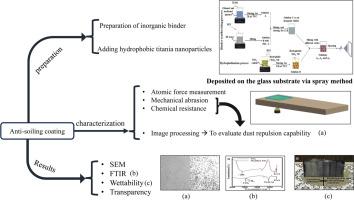透明自清洁SiO2/TiO2杂化涂层坚固疏水太阳能电池盖板玻璃的实验研究
Q1 Chemical Engineering
引用次数: 0
摘要
利用先进的喷涂技术,开发出具有透明度,自清洁能力,耐用性和耐水性的尖端涂层。通过将改性二氧化钛(TiO2)纳米颗粒与二氧化硅(SiO2)粘合剂结合,将一种强效溶液应用于玻璃表面。该涂层具有良好的防水性能,其接触角范围为121.7°至143.2°,具有良好的弹性。在扫描电子显微镜(SEM)的观察下,一个迷人的纳米颗粒图案出现在玻璃上,形成独特的微纳结构。光谱分析,采用紫外可见光谱(UV-Vis)技术,确认涂层的能力,保持清晰度和提高半透明。在光伏组件上进行的测试证实了该涂层的自清洁性能。此外,采用图像处理方法对涂层的除尘器性能进行了评价。涂层对碱性溶液表现出很强的抵抗力,即使在氢氧化钠中浸泡后,也能保持与未暴露样品相当的污染比。同样,评价了涂层在砂纸上机械磨损后对粉尘颗粒的排斥性能。经过4次循环后,涂层的粗糙度有所改善,涂层的使用效果增强。然而,超过五次机械磨损循环,涂层发生降解,导致其从表面脱落。这种创新技术在各种应用中具有巨大的潜力,有望在光学环境中提高性能和耐用性。本文章由计算机程序翻译,如有差异,请以英文原文为准。

Experimental investigation of robust and hydrophobic solar cell cover glass with transparent, self-cleaning hybrid SiO2/TiO2 coatings
Utilizing advanced spray-coating techniques, a cutting-edge coating is developed, boasting transparency, self-cleaning capabilities, durability, and water resistance. By combining modified titanium dioxide (TiO2) nanoparticles with a silica (SiO2) binder, a potent solution is applied to glass surfaces. This coating effectively repels water, exhibiting contact angles ranging from 121.7° to 143.2°, showcasing its resilience. Under the scrutiny of Scanning Electron Microscopy (SEM), a captivating nanoparticle pattern emerges on the glass, forming a unique micro-nano architecture. Spectroscopic analysis, employing Ultraviolet–visible spectroscopy (UV-Vis) technology, affirms the coating's ability to maintain clarity and enhance translucency. Tested on a Photovoltaic module, the coating's self-cleaning properties are confirmed. Additionally, an image processing approach was employed to assess the coating's performance in dust repulsion. The coating exhibited strong resistance to basic solutions, maintaining a comparable soiled ratio to the unexposed sample even after soaking in sodium hydroxide. Similarly, the coating's performance in repelling dust particles after mechanical abrasion on sandpaper was evaluated. After four cycles, the coating showed improvement in roughness, enhancing its efficacy. However, beyond five cycles of mechanical abrasion, coating degradation occurred, leading to its removal from the surface. This innovative technology holds immense potential for a variety of applications, promising heightened performance and durability in optical environments.
求助全文
通过发布文献求助,成功后即可免费获取论文全文。
去求助
来源期刊

International Journal of Thermofluids
Engineering-Mechanical Engineering
CiteScore
10.10
自引率
0.00%
发文量
111
审稿时长
66 days
 求助内容:
求助内容: 应助结果提醒方式:
应助结果提醒方式:


